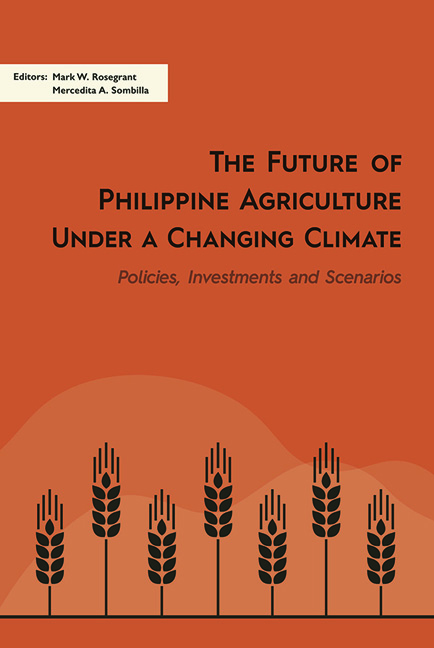Book contents
- Frontmatter
- Contents
- List of Tables
- List of Figures
- List of Appendices
- Preface
- Acknowledgements
- List of Contributors
- PART I Setting up the Scenarios: Current Status and Potential Impacts of Climate Change to Philippine Agriculture
- PART II Climate Change Adaptation Strategies and Sustainability of Philippine Agriculture
- PART III Investments and Supporting Policies to Alleviate Climate Change Impacts to Philippine Agriculture
- PART IV Conclusion
- Index
Preface
Published online by Cambridge University Press: 29 May 2019
- Frontmatter
- Contents
- List of Tables
- List of Figures
- List of Appendices
- Preface
- Acknowledgements
- List of Contributors
- PART I Setting up the Scenarios: Current Status and Potential Impacts of Climate Change to Philippine Agriculture
- PART II Climate Change Adaptation Strategies and Sustainability of Philippine Agriculture
- PART III Investments and Supporting Policies to Alleviate Climate Change Impacts to Philippine Agriculture
- PART IV Conclusion
- Index
Summary
The Philippines is highly vulnerable to climatic stresses, and droughts and floods have substantially affected agricultural production over time. In particular, El Niño Southern Oscillation (ENSO)–related droughts have affected the country's water resources and temperatures, with flow-on effects to the agricultural sector, as well as to health and the environment. In addition to more frequent and severe flooding and drought, the Philippines has also experienced many catastrophic natural disasters, particularly typhoons. Yolanda (internationally known as Haiyan) devastated the country in 2013, causing 6,300 deaths; the displacement of over 5 million citizens; an estimated 89.60 billion Philippine peso (PhP) in property damage to houses, hospitals, schools, roads, bridges, and so on; and PhP42.76 billion in losses to the productive sectors, including agriculture. Consequently, the Philippines ranks high in the Global Climate Risk Index, taking first place in 2013. As recently as December 2017, Typhoons Urduja and Vinta (internationally known as Tembin and Kai-Tak, respectively) once again caused the loss of hundreds of lives, along with the destruction of property, infrastructure, and livelihoods.
The current state of climate science research does not attribute extreme events like floods, droughts, or typhoons to climate change, but there is growing consensus that climate change increases the frequency and severity of such events. In combination with key drivers of food production growth — such as income and population growth, investment in research and technology, and changes in dietary patterns — climate change will have a major impact on Philippine farmers’ ability to produce sufficient food and generate enough income to support healthy and productive lives. Poor and vulnerable communities are the most severely affected based on their reliance on subsistence farming and their limited capacity to undertake measures to adapt to climate change, which is of critical importance to sustaining agricultural production growth in the pursuit of food security and poverty reduction. Failure to adapt to climate change would make the Philippines even more susceptible both to extreme events and to the long-term impacts of climate change. The country must prepare for these impacts and enhance its capacity to deal with them economically, institutionally, scientifically, and technically.
- Type
- Chapter
- Information
- The Future of Philippine Agriculture under a Changing ClimatePolicies, Investments and Scenarios, pp. xxii - xxxiPublisher: ISEAS–Yusof Ishak InstitutePrint publication year: 2018

